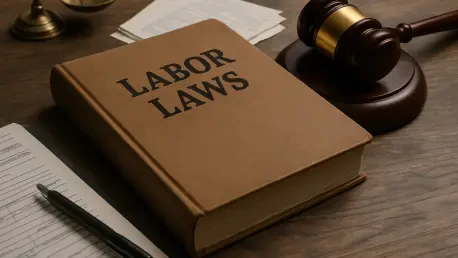As we dive into the complex landscape of labor and employment law under President Donald Trump’s second term, I’m thrilled to sit down with Sofia Khaira, a renowned specialist in diversity, equity, and inclusion. With her deep expertise in helping businesses navigate talent management and foster equitable workplaces, Sofia offers invaluable insights into the dramatic policy shifts outlined in Littler’s 2025 Labor Day Report. Today, we’ll explore the upheaval at federal agencies, the evolving dynamics of union membership, the contentious debate around DEI programs, and the uncertainties surrounding overtime rules, worker classification, immigration enforcement, and AI regulations. Let’s unpack how these changes are reshaping the workplace and what they mean for employers and employees alike.
How have the recent firings of officials at agencies like the EEOC and NLRB under the Trump administration impacted their operations?
The firings have created significant disruption. Shortly after taking office, several key officials at the Equal Employment Opportunity Commission and the National Labor Relations Board were dismissed, leaving both agencies without a quorum. This means they’re essentially paralyzed in terms of making major decisions or enforcing policies. For employers and workers who rely on these agencies for guidance or dispute resolution, it’s a waiting game until new nominees are confirmed or legal challenges are resolved. The immediate effect is a vacuum in oversight and enforcement, which can lead to uncertainty in how workplace laws are interpreted or applied.
What’s at stake with the Trump administration’s challenge to the Humphrey’s Executor v. United States decision?
This challenge is a big deal because it questions a nearly century-old Supreme Court ruling that protects the independence of federal agencies. Humphrey’s Executor established that Congress could create independent boards and commissions, limiting a president’s power to remove members at will. If the Trump administration succeeds in overturning this, it could mean that agencies like the EEOC or NLRB would no longer operate with the same level of autonomy. Instead, they might simply align with the policy priorities of whoever is in the White House, which could dramatically shift how labor and employment laws are enforced from one administration to the next.
Why do you think union membership continues to decline despite an increase in organizing efforts?
It’s a paradox, but there are a few factors at play. Even though we’re seeing more union organizing and elections, the overall workforce is growing faster than union membership, especially in sectors that are harder to organize, like tech or gig economy roles. Additionally, there’s a cultural shift—younger workers might not see unions as relevant to their needs, or they’re wary of the costs versus benefits. Economic pressures and employer resistance also play a role. Many companies are doubling down on anti-union messaging, and without strong federal support, it’s tough for unions to gain traction, leading to record lows in membership density in 2024.
Can you explain what ‘captive audience’ meetings are and how state laws restricting them are affecting employers?
Captive audience meetings are sessions where employers require workers to attend and listen to the company’s perspective, often about unionization. They’ve been a common tool for employers to share their views, especially during union campaigns. However, 13 states have now passed laws to ban or limit these meetings, arguing they can feel coercive to employees. For employers, this is a challenge because it restricts their ability to communicate directly with their workforce about the potential downsides of unionizing. They’re at a disadvantage when a union campaign ramps up quickly, as they lose a key platform to counter union messaging.
How is the Trump administration approaching diversity, equity, and inclusion programs, and what might this mean for employers?
The administration has taken a very aggressive stance against DEI programs, directing federal agencies to dismantle them wherever possible. This reflects a broader push to eliminate initiatives seen as prioritizing identity over merit. For employers, especially those with existing DEI programs, this creates a tricky landscape. While federal actions target government agencies, there’s a ripple effect—private sector employers might face scrutiny or legal challenges if policies are perceived as aligning with federal pushback. It’s crucial for companies to stay informed, consult legal counsel, and be prepared for potential state-level counteractions that could protect or even expand DEI efforts.
What uncertainties are employers facing with changes to overtime rules and worker classification under this administration?
There’s a lot up in the air right now. The Biden administration’s 2024 overtime rule, which raised the salary threshold for white-collar exemptions, was struck down by a federal judge, and the Trump administration is deciding whether to appeal or let the older 2019 rule stand. On worker classification, there’s a move to loosen rules, potentially allowing more people to be classified as independent contractors, which benefits employers seeking flexibility but raises concerns about worker protections. Meanwhile, some states are pushing back with stricter standards to ensure more workers are classified as employees. Employers are caught in the middle, navigating conflicting federal and state approaches without a clear roadmap.
How are immigration policy changes under this administration affecting the labor market and employer responsibilities?
The Trump administration has prioritized stricter immigration enforcement, which translates to more I-9 audits and workplace raids. For employers, this means heightened scrutiny over employment authorization documentation and a need for meticulous record-keeping. At the same time, hiring international talent is becoming tougher due to tighter interpretations of immigration rules. Industries like long-term care and construction, which already face labor shortages, are feeling the pinch. Economists have noted that immigration has been key to filling labor gaps, especially post-COVID, so these restrictions could exacerbate staffing challenges across sectors.
With the federal government stepping back from AI regulation, how are states shaping the conversation around AI in the workplace?
The Trump administration’s focus on deregulation and tech competitiveness has left a void in federal oversight of AI in employment contexts. States and localities are stepping in, crafting their own rules to address issues like algorithmic bias, transparency, and worker surveillance. This creates a patchwork of regulations that employers must navigate, raising questions about compliance and risk. For instance, one state might require detailed disclosures about AI in hiring, while another has no rules at all. Employers need flexible AI ethics policies that can adapt to this evolving landscape and keep pace with both tech advancements and regulatory shifts.
What is your forecast for the future of labor and employment policy under this administration?
I anticipate continued turbulence. The push to reshape federal agencies, roll back certain worker protections, and prioritize deregulation will likely intensify as key positions are filled. However, we’ll also see strong pushback from blue states, creating a tug-of-war between federal and state priorities on issues like DEI, worker classification, and AI. For employers, this means ongoing uncertainty and the need to stay agile. I expect court rulings on agency independence and overtime rules will be pivotal, potentially setting long-term precedents. My forecast is that the divide between employer-friendly and worker-friendly policies will grow sharper, making strategic planning and legal preparedness more critical than ever.









